Chevra Bikur Cholim (Hebrew for Society for visiting the sick) incorporated in Seattle in 1891 with the purpose of caring for the sick and providing proper burial. Within a decade it had evolved into a religious congregation. Before incorporating, the chevra held Simchas Torah (Rejoicing with the Torah) services in 1889 in Red Man's Hall on 2nd Avenue and Seneca Street. Burial grounds were purchased at Oak Lake around 1890. Bikur Cholim's first synagogue was a remodeled private residence, at 14th Avenue and Washington Street. It became the center of religious and social activity for orthodox Jewry.
First Rabbi
In 1893, Rabbi Hirsch Genss gave the congregation a Torah. In addition to running a grocery and butcher shop, Rabbi Genss served as the congregation's first rabbi. Although he was not officially elected or given a formal salary, he performed the duties of the schochet (ritual slaughterer), mohel (one who performs circumcision), and rabbinical authority.
In 1897, Zalman Grodinsky helped the chevra to purchase the property for a synagogue at 13th Avenue and Washington Street. In 1898, on Rosh Hashanah (the Jewish New Year), the doors opened for worshippers, but the Klondike Gold Rush had increased the population of Seattle by so much that auxiliary services had to be held in Morris Hall.
In 1909, property was purchased to build a synagogue at 17th Avenue and Yesler Way. For five years, services were conducted in the vestry of the partially completed building. The architect B. Marcus Priteca, whose work includes Seattle's Coliseum and Orpheum theaters, designed the synagogue. It was dedicated in 1915 and served as Bikur Cholim's home for nearly 60 years. In 1969 the congregation sold the synagogue building to the city of Seattle (although it continued to hold some services and events in the building through 1971), and the city developed it into a community, cultural, and arts center named for Harlem Renaissance writer and poet Langston Hughes (1902-1967).
Rabbis serving Bikur Cholim have included:
- Rabbi Gedaliah Halpern (first officially elected rabbi)
- Rabbi Simon Glazer (1918)
- Rabbi Simon Winograd (1923-1929)
- Rabbi Soloman P. Wohlgelernter (1930-1947)
- Rabbi Gershin Appel (1948-1958)
- Rabbi Sholom Rivkin (1959-1969)
- Rabbi Moses Lodinsky (1972-1992)
- Rabbi Moshe Kletenik
A Place for Education
Bikur Cholim has long provided for Jewish education. The earliest documented date is 1898, when a Talmud Torah (after-school program in Hebrew and Torah) was established. Bikur Cholim allocated a parcel of land from its 13th Avenue and Washington Street site for this purpose. In 1920, the synagogue was a leader in establishing a city-wide Talmud Torah. In 1925, Bikur Cholim organized Yeshiva Rabeinu Hayim Ozer, a Jewish religious academy.
During World War I, when the Atlantic ports were closed to all but war-priority shipping, many European Jewish refugees entered through Pacific ports. Bikur Cholim took in many refugees and assisted with employment and resettlement. The Congregation was active in the Seattle Jewish War Relief Committee and in Hebrew Immigrant Aid. This work continued with the establishment of the Hachnosas Orchim (welcoming the stranger) Society in 1932, which provided food and lodging for those in need. As the Nazis rose to power in Germany, European refugees came to Seattle by the same route as refugees who fled in World War I – through Russia, Siberia, China, Japan, and across the Pacific. The work of resettlement and help for refugees continued.
Mergers and Name Change
In 1964, Bikur Cholim merged with Yavneh Congregation. Yavneh membership had formed out of the need of Bikur Cholim members living in the Seward Park neighborhood to have a schul (service) within walking distance. These members had broken away from Bikur Cholim and reunited in 1964. In 1971, Bikur Cholim changed its name, after 80 years. Reflecting a merger with Congregation Machzikay-Hadath (founded in 1930), the name became Bikur Cholum Machzikay Hadath.
In 1966, Bikur Cholim purchased property in Seward Park. High Holy Day services were held in an interim synagogue on the site until 1972, at which time the completed synagogue was dedicated. In 1990, the congregation erected an Eruv in Seward Park. Ordinarily, Halachah (Jewish laws and regulations) forbids carrying or pushing anything on Shabbat (Sabbath), but within the borders of the Eruv (a wire cord stretched from telephone pole to pole, in accordance with Orthodox law) worshippers may carry essentials and push baby strollers.
In 1991, Bikur Cholim celebrated its centennial. In 2004, Shabbat and holiday services typically drew 300 people, including 100 children. Bikur Cholim was the only synagogue in the city that conducted morning, afternoon, and evening services every day of the year.

